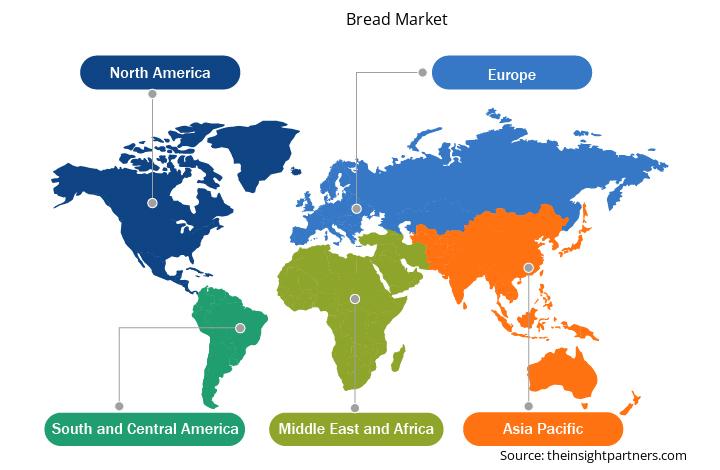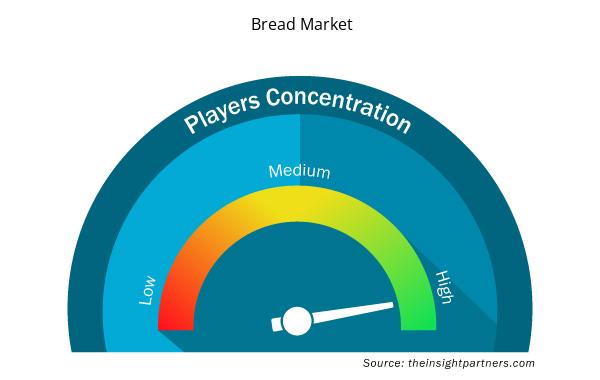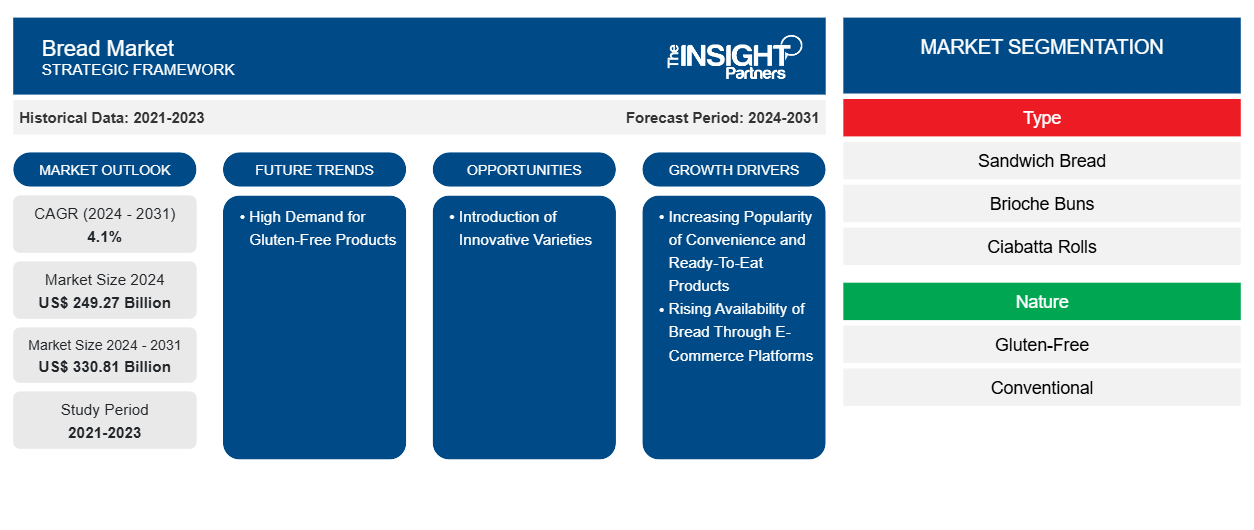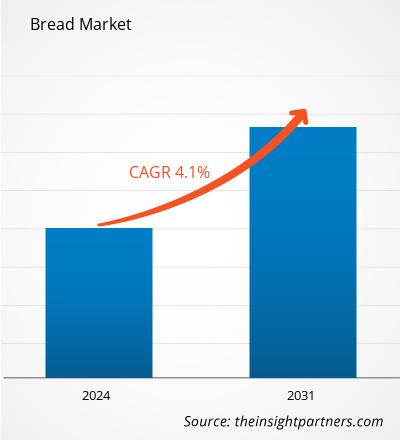面包市场规模预计将从 2024 年的 2492.7 亿美元增至 2031 年的 3308.1 亿美元。预计 2024-2031 年期间,市场复合年增长率将达到 4.1%。在预测期内,无麸质产品的日益普及可能会为市场带来新的趋势。
面包市场分析
由于人们越来越喜欢方便和即食产品,全球面包市场的公司正经历着需求激增。忙碌的生活方式以及对快速和简化膳食解决方案的需求导致全球面包消费量大幅增加。消费者根据标签上提供的成分规格选择无麸质、低碳水化合物、高纤维或全麦面包产品。消费者不断变化的优先事项和对更健康替代品的日益偏好导致了对有机面包、法棍面包、百吉饼、小圆面包和面包卷的需求。作为回应,面包制造商也在广泛创新其产品,通过加入种子、坚果、古代谷物、蔬菜和不同维生素和矿物质等功能性成分,提供手工面包、功能性面包和强化面包。因此,消费者在口味方面不断变化的需求导致了对特色面包和功能性面包的高需求,这有望为面包生产商提供有利可图的机会。
面包市场概况
面包是世界各地都喜欢的主食。它有着数千年的悠久历史,是不同文化烹饪传统中不可或缺的一部分。从切片面包到法棍面包和百吉饼,每个地区都有独特的面包品种,反映了当地的风味和习俗。它由用面粉(小麦、大麦、燕麦、黑麦和其他面粉)、酵母和糖制成的面团制成,通常通过烘烤制成。它是全球大部分地区的主要食物。它是最古老的烘焙食品之一,自农业开始以来就具有重要意义。它也是宗教仪式和日常文化中重要组成部分的再现。它是家庭、餐馆和咖啡馆的常见食品;此外,它也常用于三明治和面包卷等食谱中。工作专业人士的人数不断增加、工作日程繁忙和生活方式繁忙,导致对方便即食食品的需求大幅增加,包括面包,这些食品可以作为早餐、零食或无需太多准备的正餐食用。此外,城市化进程加快和西方美食的影响力不断增强,预计将在预测期内为全球面包市场的增长创造丰厚的机会。
定制此报告以满足您的需求
您可以免费定制任何报告,包括本报告的部分内容、国家级分析、Excel 数据包,以及为初创企业和大学提供优惠和折扣
- 获取此报告的关键市场趋势。这个免费样品将包括数据分析,从市场趋势到估计和预测。
面包市场的驱动因素和机遇
电子商务平台面包供应量不断增加,推动市场增长
随着消费者越来越多地转向网上购物以寻求便利,面包市场有望从更高的知名度和更广泛的产品供应中受益。电子商务渠道为消费者提供了在家中舒适地订购烘焙食品的便利。消费者可以在下订单之前浏览各种各样的面包,比较价格,并通过参考标签说明和其他消费者的评论来选择值得信赖的品牌产品。电子商务的这种便利性对于忙碌的个人或那些可能无法轻松进入实体杂货店的人特别有吸引力。根据加拿大农业部的数据,在美国,从 2019 年到 2023 年,杂货电子商务销售额每年增长 26.4%。此外,根据欧洲电子商务的数据,2023 年欧洲 B2C 电子商务总营业额小幅增长 3%,从 8640 亿欧元增至 8870 亿欧元。电子商务平台为面包生产商提供了接触全球消费者的直接渠道。通过利用电子商务平台,面包制造商可以克服地理限制和分销挑战等传统障碍,并开拓其本地区域以外的新市场。此外,这些平台为他们提供了展示产品和直接与消费者沟通的灵活性,从而提高了品牌知名度和客户参与度。
此外,通过绕过中间商和传统零售渠道,烘焙制造商可以更好地了解消费者的喜好,获得反馈,并相应地定制他们的产品。因此,市场上的主要参与者,如 Grupo Bimbo SAB de CV、Dr Schar AG、Dimpflmeier Bakery Ltd、Campbell Soup Co. 和 Wonder Brands Inc. 正在通过电子商务平台分销他们的烘焙食品来促进他们的业务,这反过来又促进了全球面包市场的增长。
引进创新品种创造市场增长机会
消费者根据标签上提供的成分规格选择无麸质、低碳水化合物、高纤维或全麦面包产品。消费者不断变化的优先事项和对更健康替代品的日益偏好导致了对有机面包、法棍面包、百吉饼、小圆面包和面包卷的需求。作为回应,面包制造商也在广泛创新其产品,通过加入种子、坚果、传统谷物、蔬菜和不同维生素和矿物质等功能性成分,提供手工面包、功能性面包和强化面包。一些面包师还使用胡萝卜、甜菜根、菠菜和其他蔬菜等不同寻常的成分组合制作传统面包和面包。此外,孜然、姜黄和肉桂作为尝试口味的特殊成分越来越受到认可。Grupo Bimbo SAB de CV 面包制造商旗下品牌 Sara Lee 于 2023 年 1 月宣布推出“用蔬菜制成的白面包”,作为其产品组合的最新成员。新推出的产品每条面包用相当于一杯蔬菜烘焙而成,富含维生素 A、D 和 E,突出了在任何一餐中添加额外营养的实用方法。2024 年 5 月,Grupo Bimbo SAB de CV 的子公司 Bimbo Bakeries USA 在其 Sara Lee Artesano 产品组合中推出了夏威夷面包店面包和小圆面包。这两款新面包产品提供美味、香甜的面包和小圆面包,具有完美的热带风味,不含人工香料、防腐剂或高果糖玉米糖浆。Nature's Harvest(Grupo Bimbo SAB de CV 的一个品牌)宣布将于 2022 年 6 月在加利福尼亚州(美国)重新推出其全系列面包产品。重新推出旨在将两个新品种引入其“全麦黄油和白面包”产品组合,该组合采用更新的包装,外观和感觉焕然一新。重新推出需要根据消费者洞察对 Nature's Harvest 的品种、口味和包装进行改进。通过此举,该品牌强调了其在加州当地烘焙每条面包的承诺。
面包市场报告细分分析
有助于得出面包市场分析的关键部分是类型、性质、类别和应用。
- 根据类型,面包市场分为三明治面包、奶油蛋卷、恰巴塔面包卷、法式长棍面包、帕尼尼和佛卡夏面包、汉堡面包、热狗面包等。三明治面包在 2024 年占据了最大的市场份额。
- 根据性质,市场分为无麸质和传统两类。2024 年,传统部分占据了市场主导地位。
- 根据类别,市场分为冷冻和常温食品以及冷藏食品。常温食品和冷藏食品在 2024 年占据了更大的市场份额。
- 就最终用途而言,市场分为零售和餐饮服务。零售业在 2024 年占据了更大的市场份额。
面包市场份额按地区分析
面包市场报告的地理范围分为五个区域:北美、亚太、欧洲、中东和非洲以及南美和中美洲。预计亚太地区的面包市场在预测期内将大幅增长。
由于印度、日本和中国等国的消费量不断增长,亚太地区的烘焙业呈现出显著增长。由于消费者对方便即食食品的偏好日益增加,尤其是烘焙食品(面包、法棍、小圆面包和面包卷),以及西方饮食的吸引力不断增加,该地区对不同类型面包的需求正在增加。在不断的城市化过程中,该地区的生活方式变得越来越忙碌,这促使消费者选择快速方便的膳食,使面包成为一种有吸引力的选择。此外,人们对健康和保健的认识不断提高,促使消费者寻找更健康的面包选择,例如提供营养价值的全麦、杂粮和无麸质品种。因此,该地区的消费者越来越多地选择以小米为基础的食品作为膳食。为了满足对小米烘焙产品的需求,在亚太地区运营的烘焙品牌越来越多地推出新产品。然而,传统饮食习惯和文化偏好在印度、中国、韩国和其他亚洲国家盛行;因此,这些国家的人们优先选择大米、小麦、小米、豆类、奶制品、蔬菜、水果、面条等主食,而不是面包,从而限制了该地区的市场。
面包市场区域洞察
Insight Partners 的分析师已详尽解释了预测期内影响面包市场的区域趋势和因素。本节还讨论了北美、欧洲、亚太地区、中东和非洲以及南美和中美洲的面包市场细分和地理位置。

- 获取面包市场的区域特定数据
面包市场报告范围
| 报告属性 | 细节 |
|---|---|
| 2024 年的市场规模 | 2492.7亿美元 |
| 2031 年市场规模 | 3308.1亿美元 |
| 全球复合年增长率(2024 - 2031) | 4.1% |
| 史料 | 2021-2023 |
| 预测期 | 2024-2031 |
| 涵盖的领域 | 按类型
|
| 覆盖地区和国家 | 北美
|
| 市场领导者和主要公司简介 |
|
面包市场参与者密度:了解其对业务动态的影响
面包市场正在快速增长,这得益于终端用户需求的不断增长,而这些需求又源于消费者偏好的不断变化、技术进步以及对产品优势的认识不断提高等因素。随着需求的增加,企业正在扩大其产品范围,进行创新以满足消费者的需求,并利用新兴趋势,从而进一步推动市场增长。
市场参与者密度是指在特定市场或行业内运营的企业或公司的分布情况。它表明在给定市场空间中,相对于其规模或总市场价值,有多少竞争对手(市场参与者)存在。
在面包市场运营的主要公司有:
- 灯笼式 Unibake
- 富品公司
- 拉布雷亚面包店
- 鲜花食品公司
- 宾堡集团
免责声明:上面列出的公司没有按照任何特定顺序排列。

- 获取面包市场顶级关键参与者的概述
面包市场新闻和最新动态
通过收集一手和二手研究后的定性和定量数据来评估面包市场,其中包括重要的公司出版物、协会数据和数据库。面包市场的一些关键发展如下:
- 2023 年 4 月,波恩集团旗下品牌 Britannia 为印度消费者推出了不含麦达的“小米面包”。这款面包产品加入了 ragi、jowar、bajra 和燕麦,含有大量纤维和矿物质,为消费者提供了一种方便的方式,可以在膳食中加入小米类食物。(来源:Britannia,公司网站,2024 年 4 月)
- Lantmännen Unibake Sweden 重新推出了一系列汉堡面包和热狗卷,其中添加了更多全麦和纤维。其目标是让瑞典消费者更有兴趣选择比传统快餐更健康的替代品。(来源:Lantmännen Unibake Sweden,新闻稿,2024 年 4 月)
面包市场报告覆盖范围和交付成果
“面包市场规模和预测(2021-2031)”报告对以下领域进行了详细的市场分析:
- 范围内涵盖的所有主要细分市场的全球、区域和国家层面的面包市场规模和预测
- 面包市场趋势以及市场动态,如驱动因素、限制因素和关键机遇
- 详细的波特五力分析和 SWOT 分析
- 面包市场分析涵盖主要市场趋势、全球和区域框架、主要参与者、法规和最新市场发展
- 行业格局和竞争分析,涵盖市场集中度、热图分析、知名参与者以及面包市场的最新发展
- 详细的公司简介
- 历史分析(2 年)、基准年、预测(7 年)及复合年增长率
- PEST 和 SWOT 分析
- 市场规模价值/数量 - 全球、区域、国家
- 行业和竞争格局
- Excel 数据集


- Pipe Relining Market
- Excimer & Femtosecond Ophthalmic Lasers Market
- Terahertz Technology Market
- Environmental Consulting Service Market
- Animal Genetics Market
- Clinical Trial Supplies Market
- Integrated Platform Management System Market
- Nuclear Waste Management System Market
- Constipation Treatment Market
- Vision Care Market

Report Coverage
Revenue forecast, Company Analysis, Industry landscape, Growth factors, and Trends

Segment Covered
This text is related
to segments covered.

Regional Scope
North America, Europe, Asia Pacific, Middle East & Africa, South & Central America

Country Scope
This text is related
to country scope.
常见问题
Europe accounted for the largest share of the market in 2024.
The increasing popularity of convenience and ready-to-eat products, and the rising availability of bread through e-commerce platforms are major factors contributing to market growth.
High demand for gluten-free products is likely to bring key trends in the market in the future.
Lantmannen Unibake, Rich Products Corp, La Brea Bakery, Flowers Foods Inc, Grupo Bimbo SAB de CV, Fiera Foods Company, La Lorraine Bakery Group, EUROPASTRY, SA, Bäckerhaus Veit GmbH, Schripps European Bread, Vandemoortele NV, Upper Crust, FGF Brands Inc, VIVESCIA, and Conagra Brands Inc. are a few key players operating in the market.
The market size is projected to reach US$ 330.81 billion by 2031.
Trends and growth analysis reports related to Food and Beverages : READ MORE..
The List of Companies - Bread Market
- Lantmannen Unibake
- Rich Products Corp
- La Brea Bakery
- Flowers Foods Inc
- Grupo Bimbo SAB de CV
- Fiera Foods Company
- La Lorraine Bakery Group
- FGF Brands Inc
- VIVESCIA
- Conagra Brands Inc.
The Insight Partners performs research in 4 major stages: Data Collection & Secondary Research, Primary Research, Data Analysis and Data Triangulation & Final Review.
- Data Collection and Secondary Research:
As a market research and consulting firm operating from a decade, we have published and advised several client across the globe. First step for any study will start with an assessment of currently available data and insights from existing reports. Further, historical and current market information is collected from Investor Presentations, Annual Reports, SEC Filings, etc., and other information related to company’s performance and market positioning are gathered from Paid Databases (Factiva, Hoovers, and Reuters) and various other publications available in public domain.
Several associations trade associates, technical forums, institutes, societies and organization are accessed to gain technical as well as market related insights through their publications such as research papers, blogs and press releases related to the studies are referred to get cues about the market. Further, white papers, journals, magazines, and other news articles published in last 3 years are scrutinized and analyzed to understand the current market trends.
- Primary Research:
The primarily interview analysis comprise of data obtained from industry participants interview and answers to survey questions gathered by in-house primary team.
For primary research, interviews are conducted with industry experts/CEOs/Marketing Managers/VPs/Subject Matter Experts from both demand and supply side to get a 360-degree view of the market. The primary team conducts several interviews based on the complexity of the markets to understand the various market trends and dynamics which makes research more credible and precise.
A typical research interview fulfils the following functions:
- Provides first-hand information on the market size, market trends, growth trends, competitive landscape, and outlook
- Validates and strengthens in-house secondary research findings
- Develops the analysis team’s expertise and market understanding
Primary research involves email interactions and telephone interviews for each market, category, segment, and sub-segment across geographies. The participants who typically take part in such a process include, but are not limited to:
- Industry participants: VPs, business development managers, market intelligence managers and national sales managers
- Outside experts: Valuation experts, research analysts and key opinion leaders specializing in the electronics and semiconductor industry.
Below is the breakup of our primary respondents by company, designation, and region:

Once we receive the confirmation from primary research sources or primary respondents, we finalize the base year market estimation and forecast the data as per the macroeconomic and microeconomic factors assessed during data collection.
- Data Analysis:
Once data is validated through both secondary as well as primary respondents, we finalize the market estimations by hypothesis formulation and factor analysis at regional and country level.
- Macro-Economic Factor Analysis:
We analyse macroeconomic indicators such the gross domestic product (GDP), increase in the demand for goods and services across industries, technological advancement, regional economic growth, governmental policies, the influence of COVID-19, PEST analysis, and other aspects. This analysis aids in setting benchmarks for various nations/regions and approximating market splits. Additionally, the general trend of the aforementioned components aid in determining the market's development possibilities.
- Country Level Data:
Various factors that are especially aligned to the country are taken into account to determine the market size for a certain area and country, including the presence of vendors, such as headquarters and offices, the country's GDP, demand patterns, and industry growth. To comprehend the market dynamics for the nation, a number of growth variables, inhibitors, application areas, and current market trends are researched. The aforementioned elements aid in determining the country's overall market's growth potential.
- Company Profile:
The “Table of Contents” is formulated by listing and analyzing more than 25 - 30 companies operating in the market ecosystem across geographies. However, we profile only 10 companies as a standard practice in our syndicate reports. These 10 companies comprise leading, emerging, and regional players. Nonetheless, our analysis is not restricted to the 10 listed companies, we also analyze other companies present in the market to develop a holistic view and understand the prevailing trends. The “Company Profiles” section in the report covers key facts, business description, products & services, financial information, SWOT analysis, and key developments. The financial information presented is extracted from the annual reports and official documents of the publicly listed companies. Upon collecting the information for the sections of respective companies, we verify them via various primary sources and then compile the data in respective company profiles. The company level information helps us in deriving the base number as well as in forecasting the market size.
- Developing Base Number:
Aggregation of sales statistics (2020-2022) and macro-economic factor, and other secondary and primary research insights are utilized to arrive at base number and related market shares for 2022. The data gaps are identified in this step and relevant market data is analyzed, collected from paid primary interviews or databases. On finalizing the base year market size, forecasts are developed on the basis of macro-economic, industry and market growth factors and company level analysis.
- Data Triangulation and Final Review:
The market findings and base year market size calculations are validated from supply as well as demand side. Demand side validations are based on macro-economic factor analysis and benchmarks for respective regions and countries. In case of supply side validations, revenues of major companies are estimated (in case not available) based on industry benchmark, approximate number of employees, product portfolio, and primary interviews revenues are gathered. Further revenue from target product/service segment is assessed to avoid overshooting of market statistics. In case of heavy deviations between supply and demand side values, all thes steps are repeated to achieve synchronization.
We follow an iterative model, wherein we share our research findings with Subject Matter Experts (SME’s) and Key Opinion Leaders (KOLs) until consensus view of the market is not formulated – this model negates any drastic deviation in the opinions of experts. Only validated and universally acceptable research findings are quoted in our reports.
We have important check points that we use to validate our research findings – which we call – data triangulation, where we validate the information, we generate from secondary sources with primary interviews and then we re-validate with our internal data bases and Subject matter experts. This comprehensive model enables us to deliver high quality, reliable data in shortest possible time.


 获取此报告的免费样本
获取此报告的免费样本